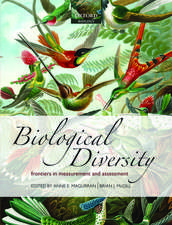Macroecology: Concepts and Consequences: 43rd Symposium of the British Ecological Society: Symposia of the British Ecological Society
Editat de Tim M. Blackburn, Kevin J. Gastonen Limba Engleză Paperback – 31 iul 2003
Preț: 612.62 lei
Preț vechi: 688.34 lei
-11% Nou
Puncte Express: 919
Preț estimativ în valută:
117.24€ • 121.95$ • 96.79£
117.24€ • 121.95$ • 96.79£
Carte tipărită la comandă
Livrare economică 15-29 aprilie
Preluare comenzi: 021 569.72.76
Specificații
ISBN-13: 9780521549325
ISBN-10: 0521549329
Pagini: 464
Ilustrații: 136 b/w illus.
Dimensiuni: 171 x 248 x 25 mm
Greutate: 0.73 kg
Editura: Cambridge University Press
Colecția Cambridge University Press
Seria Symposia of the British Ecological Society
Locul publicării:Cambridge, United Kingdom
ISBN-10: 0521549329
Pagini: 464
Ilustrații: 136 b/w illus.
Dimensiuni: 171 x 248 x 25 mm
Greutate: 0.73 kg
Editura: Cambridge University Press
Colecția Cambridge University Press
Seria Symposia of the British Ecological Society
Locul publicării:Cambridge, United Kingdom
Cuprins
1. Introduction: why Macroecology? Tim M. Blackburn and Kevin J. Gaston; Part I. Why Are Some Taxa More Diverse Than Others?: 2. Evolutionary analysis of species richness patterns in aquatic beetles: why macroecology needs a historical perspective Alfried P. Vogler and Ignacio Ribera; 3. The unified phenomenological theory of biodiversity Sean Nee; Part II. Why Are Most Species Rare?: 4. The neutral theory of biodiversity and biogeography, and beyond Stephen P. Hubbell and Jeffrey Lake; 5. Breaking the stick in space: of niche models, metacommunities and patterns in the relative abundance of species Pablo A. Marquet, Juan E. Keymer and Hernán Cofré; Part III. Why Are There More Species in the Tropics?: 6. How to reject the area hypothesis of latitudinal gradients Michael L. Rosenzweig; 7. Climatic–energetic explanations of diversity: a macroscopic perspective Robert J. Whittaker, Katherine J. Willis and Richard Field; 8. The importance of historical processes in global patterns of diversity Andrew Clarke and J. Alistair Crame; Part IV. Why are More Species Small-Bodied?: 9. Why are most species small-bodied? A phylogenetic view Andy Purvis, C. David L. Orme and Konrad Dolphin; 10. Adaptive diversification of body size: the roles of physical constraint, energetics and natural selection Brian A. Maurer; Part V. Why are some species more likely to go extinct?: 11. Life histories and extinction risk John D. Reynolds; 12. Routes to extinction Bernt-Erik Sæther and Steinar Engen; Part VI. Why Aren't Species More Widely Distributed?: 13. Why aren't species more widely distributed? Physiological and environmental limits F. Ian Woodward and C. K. Kelly; 14. Macroecology and microecology: linking large-scale patterns of abundance to population processes Andrew R. Watkinson, Jennifer A. Gill and Robert P. Freckleton; 15. Genetics and the boundaries of species' distributions R. K. Butlin, J. R. Bridle and M. Kawata; Part VII. Why Are There Interspecific Allometries?: 16. Intraspecific body size optimisation produces interspecific allometries J. Kozowski, M. Konarzewski and A. T. Gawelczyk; 17. Scaling the macroecological, and evolutionary implications of size and metabolism within and across plant taxa Brian J. Enquist; Part VIII. Why is Macroecology Important?: 18. Macroecology and conservation biology Kevin J. Gaston and Tim M. Blackburn; 19. Evolutionary macroecology and the fossil record David Jablonski, Kaustuv Roy and James W. Valentine; 20. Comparative methods for adaptive radiations Robert P. Freckleton, M. Pagel and Paul H. Harvey; 21. The next step in macroecology: from general empirical patterns to universal ecological laws James H. Brown, James F. Gillooly, Geoffrey B. West and Van M. Savage.
Recenzii
'… this new book presents for the first time a comprehensive overview which summarizes a plethora of views and applications. … The volume is written for a wide audience ranging from advanced students to established researchers. … It covers a wide range of ecological problems presenting theoretical models as well as specific applications in different research disciplines. … the volume provides an excellent overview of the cutting edge in macroecological research. … I recommend it to everyone interested in large-scale ecology.' Basic and Applied Ecology
'The book … presents macroecology at its broadest sense, with achievements that have emerged in various biological disciplines, and which thus can be treated under this label because they greatly contributed to answers of … major ecological questions … It is therefore an extremely useful reading not only for those interested in macroecology itself, but for everybody who wants to know which big ecological ideas are now in the air.' David Storch, Charles University, Czech Republic
'The book … presents macroecology at its broadest sense, with achievements that have emerged in various biological disciplines, and which thus can be treated under this label because they greatly contributed to answers of … major ecological questions … It is therefore an extremely useful reading not only for those interested in macroecology itself, but for everybody who wants to know which big ecological ideas are now in the air.' David Storch, Charles University, Czech Republic
Descriere
Provides an overview of current thinking about macroecological patterns.






















